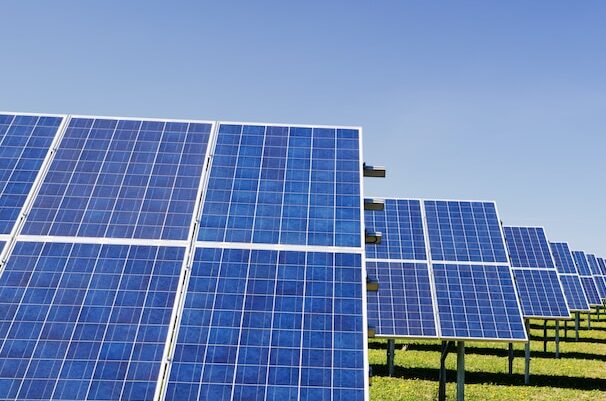Harnessing the Power of Sunlight
Solar panels are sophisticated devices that convert sunlight into electricity through a fascinating process known as the photovoltaic effect. Understanding this process is essential to grasp the mechanics behind solar energy generation.

Photovoltaic Cells: The Foundation of Solar Panels
At the core of a solar panel resides its photovoltaic technology, cells, and meticulously engineered units crafted to capture and transform sunlight into usable electricity. These cells are typically constructed using semiconductor materials like silicon, chosen for their ability to absorb sunlight and efficiently facilitate the photovoltaic process.
Each photovoltaic cell within a solar panel is a marvel of engineering, composed of multiple layers that work harmoniously to generate electricity. The P-type and N-type semiconductor layers are at the cell’s core, distinguished by their positive and negative charge carriers.
The P-type layer is doped with materials that introduce positively charged “holes” into the semiconductor lattice, creating an imbalance of positive charge carriers. Conversely, the N-type layer is doped with materials that introduce negatively charged electrons, resulting in excess negative charge carriers.
When sunlight impacts the surface of a photovoltaic cell, its energy is absorbed by the semiconductor material, causing its atoms to release electrons from their atomic orbits. This process, known as the photovoltaic effect, generates free electrons and “holes” within the semiconductor layers.
The presence of an electric field between the P-type and N-type layers of the cell facilitates the movement of these free electrons and “holes.” Electrons are attracted towards the N-type layer, while “holes” migrate towards the P-type layer. This directional movement of charge carriers creates an electric current within the cell.
The electric current generated by each cell is relatively small. However, when multiple cells are interconnected within a solar panel, their combined output can produce significant electricity. Solar panels can achieve higher voltage and current outputs that are suitable for practical applications by wiring cells in series and parallel configurations.
Generation of Direct Current (DC) Electricity
Generating direct current (DC) electricity is pivotal in solar panel systems. It is responsible for converting the captured sunlight into usable electrical energy. This transformation occurs within the individual photovoltaic cells in the solar panel array.
When sunlight impacts the surface of a photovoltaic cell, it initiates the photovoltaic effect, causing the release of free electrons within the semiconductor material. These liberated electrons are compelled to move in a particular direction due to the electric field established between the positively charged P-type layer and the negatively charged N-type layer of the cell.
Electrons within the cell create an electric current, known as direct current (DC), characterized by a steady and unidirectional flow of charge carriers. This DC electricity represents the primary output of each photovoltaic cell and serves as the foundational form of electrical energy generated by solar panels.
While the electric current produced by a single photovoltaic cell may be relatively small, the collective output of multiple interconnected cells within a solar panel amplifies the overall electricity generation capacity. Solar panels can achieve higher voltage and current outputs necessary for practical applications by wiring cells in series and parallel configurations.
Ultimately, generating direct current (DC) electricity within solar panel systems marks the crucial first step in converting sunlight into usable electrical energy. Solar panels are instrumental in the worldwide shift toward clean, renewable energy sources through advancements in photovoltaic technology and system design.
Inverter Conversion: Transforming DC to AC Electricity
Inverter Conversion: Transforming DC to AC Electricity
In the realm of solar energy, inverters play an essential role in facilitating the effortless integration of solar-generated electricity into our homes and electrical grids.
Although solar panels generate direct current (DC) electricity,
most household devices and the power grid utilize alternating current (AC) electricity. Therefore, converting DC to AC electricity is essential for maximizing the utility of solar power.
Inverters are sophisticated electronic devices tasked with this conversion process. Their primary function is to take the DC electricity produced by solar panels and transform it into the AC electricity required to power household appliances, feeding excess energy back into the grid.
The process of converting DC to AC electricity involves several key stages:
- Rectification: In the initial stage, the inverter rectifies the DC electricity, converting it from a fluctuating flow of electrons in one direction to a steady stream of electrons with consistent polarity.
- Inversion: Once the DC electricity is rectified, the inverter undergoes an inversion process. During inversion, the inverter manipulates the flow of electrons to generate an alternating current waveform that closely mimics the sinusoidal waveform of grid-supplied AC electricity.
- Synchronization: Inverters must synchronize the output AC waveform with the grid’s AC waveform to ensure compatibility and seamless integration. This synchronization process matches the frequency and phase of the output AC waveform to the grids.
- Voltage Regulation: In addition to converting DC to AC electricity, inverters also regulate the voltage levels to ensure that the output voltage aligns with the electrical grid’s and household appliances’ requirements.
By performing these intricate processes, inverters enable solar energy systems to effectively interface with existing electrical infrastructure, empowering homeowners to harness the full potential of solar power. As the demand for renewable energy grows, inverters evolve with technological advancements, driving greater efficiency, reliability, and integration capabilities within solar energy systems.
Integration with Electrical Systems: Powering Homes and Businesses
The alternating current (AC) electricity produced by solar panels has the potential to power electrical devices and appliances within homes or businesses. Any excess electricity produced can be supplied to the electrical grid or stored for future consumption.
- On-Site Consumption: Solar energy can directly power devices and appliances, reducing reliance on electricity from the grid during daylight hours.
- Grid Interaction: Excess electricity can be exported to the grid, often through net metering programs, where solar panel owners receive credits for the electricity they contribute.
Monitoring and Maintenance: Ensuring Optimal Performance
To maximize performance and efficiency, solar panel systems may include monitoring systems that track electricity production and system health. Routine maintenance, such as cleaning panels and inspecting connections, helps prolong system lifespan and performance.
- Monitoring: Monitoring systems track energy production and system health, providing valuable insights into system performance.
- Maintenance: Regular cleaning and inspection ensure optimal efficiency and prolong the lifespan of solar panel systems.
Understanding the intricacies of solar panel operation illuminates solar energy’s potential as a clean, renewable power source. Solar panels play a pivotal role in lowering carbon emissions and promoting a sustainable future through harnessing the sun’s energy.

